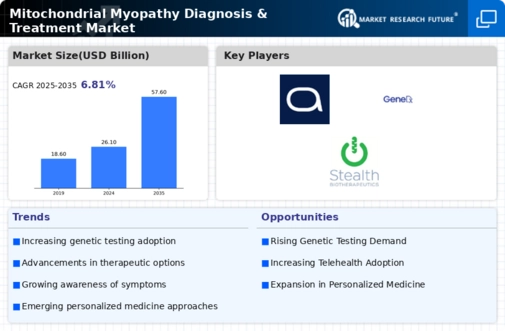Market Analysis
In-depth Analysis of Mitochondrial Myopathy Diagnosis & Treatment Market Industry Landscape
Mitochondrial myopathies, a group of rare genetic disorders stemming from genetic mutations, represent a complex spectrum of diseases that can either be inherited or arise sporadically due to de novo mutations. The Genetic and Rare Diseases Information Center (GARD) in the United States has recognized the rarity and unique nature of mitochondrial myopathies by designating them as orphan diseases.
Furthermore, Orphanet, a collaborative consortium spanning 40 countries primarily led by European nations, has similarly classified mitochondrial myopathies as orphan diseases. These conditions have been specifically identified within the Orphanet database under the orphan code - ORPHA: 206966.
The assignment of an orphan disease status to mitochondrial myopathies holds significant implications, particularly in the realm of pharmaceutical development. This designation confers several benefits to pharmaceutical companies, incentivizing them to focus on the development of treatments for these rare diseases.
One of the primary advantages of orphan disease designation is the array of incentives provided to pharmaceutical companies engaged in research and development for treatments targeting these conditions. These incentives include reduced fees for protocol assistance, streamlining the process of seeking regulatory approval for clinical trials. This reduction in fees can substantially alleviate the financial burden associated with the initial stages of drug development, encouraging more companies to invest in research efforts targeting mitochondrial myopathies.
Moreover, an orphan disease status offers protection from competition once a medicine designed for the treatment of these rare diseases is successfully marketed. Pharmaceutical companies are granted market exclusivity for a certain duration, allowing them to recover investments and potentially pave the way for further innovations in treating mitochondrial myopathies.
The orphan disease designation serves as a crucial catalyst for fostering research and development activities in the field of rare diseases. Given the limited prevalence and often complex nature of mitochondrial myopathies, these incentives play a pivotal role in incentivizing pharmaceutical companies to invest resources, time, and expertise into discovering and developing effective treatments.
The rarity and unique characteristics of mitochondrial myopathies have historically posed significant challenges in garnering attention and resources for research and drug development. The orphan disease status bestowed upon these conditions by esteemed organizations like GARD and Orphanet has brought forth a renewed focus on addressing the unmet medical needs of individuals affected by these diseases.
In conclusion, the orphan disease designation of mitochondrial myopathies by authoritative bodies such as GARD and Orphanet signifies the recognition of these conditions as rare and often overlooked diseases. This designation not only raises awareness but also provides critical incentives for pharmaceutical companies, thereby catalyzing research and development efforts aimed at finding effective treatments for mitochondrial myopathies. The benefits associated with orphan disease status play a pivotal role in facilitating advancements in understanding and managing these complex genetic disorders.






Leave a Comment